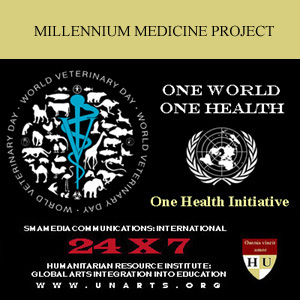OIE/FAO/WHO/IVPHC
Background Discussion
13 July 2010
Humanitarian Resource Institute
Phone: (203) 668-0282
Url: www.humanitarian.net
Pathobiologics International:
Url: www.pathobiologics.org
HRI:UNArts - Millennium Medicine Project
Url: www.unarts.org/mmp
 EID
Surveillance Notes
EID
Surveillance Notes
H5N1/H1N1 Atypical Infections: Viral Encephalitis/Meningitis
Dear Colleagues:
During this last week, I have noted 2 cases (late teen, early 20's) of
Viral Meningitis [1] in the same local vicinity in Southern CT
(personal
relatives/acquaintances). As many of you know Connecticut/New
York
City is considered by some as ground zero or an epidemiological focus
point
for corporate international air travel related transmission of high
consequence
pathogens.
These cases brought to mind two focus areas (1) my Los Alamos
discussions [2] regarding the use of microarray genomic analysis
technologies [3,4]
(100,000 gene on a chip) and (2) evolution of pandemic H1N1 as a
variable
in viral encephalitis/meningitis cases (atypical infections).
As many of you know, in 2003 OIE/FAO/WHO Pandemic Influenza:
International Contingency Planning background discussions [5,6] were
mediated by HRI:
Pathobiologics International. These discussions were associated
with
the geographic spread of Avian influenza A subtype H5NI via
migratory
birds (South Korea) and consensus that pathogen presented greatest
global
pandemic threat. As H5N1 spread across the globe, CDC, NEJM noted
that atypical infections (encephalitis, diarrheal, gastrointestinal
illness)
[7] were a serious concern associated with outbreaks worldwide.
Though
H5N1 was classified as a pandemic, from a veterinary public health
standpoint,
low human mortality allowed it to be kept under the radar screen.
This
gap is a focus in one of the current Millennium Medicine Project
background
discussions on Public Health Infrastructure and Emerging Infectious
Diseases:
[8]
The United Nations Arts Initiative is working with the
global "One Health Initiative," Humanitarian Resource Institute and
Pathobiologics International to close these gaps via collaboration
between the human medical and veterinary professions in every United
Nations member country.
Today's challenge of H5N1/H1N1 Atypical Infections (Viral
Encephalitis/Meningitis) comes with pathogenic genomic attributes of
H5NI in evolving strains of
a WHO Level 6 pandemic H1N1. While co-infections continue to be a
clinical focus point, the use of microarry for spectrum analysis of
pathogens
associated with clinical illness, would be of value, especially in
regard
to bacterial infections (including drug resistant) that can be
contained
in an effort to improve immunocompetence.
Looking forward to your feedback,
Stephen
M. Apatow
Founder, Director of Research & Development
Humanitarian Resource Institute
Humanitarian University Consortium Graduate Studies
Center for Medicine, Veterinary Medicine & Law
Phone: 203-668-0282
Email: s.m.apatow@humanitarian.net
Internet: www.humanitarian.net
Pathobiologics International
Internet: www.pathobiologics.org
Humanitarian
Intervention Initiative
Operational Security Consultancy
Internet: www.H-II.org
References:
1. Pediatrics, Meningitis and Encephalitis: Medscape/eMedicine. Url: http://emedicine.medscape.com/article/802760-overview
2. The Future of Biodetection Technologies: Los Alamos National
Laboratory, September 26-27, 2006. Url: http://www.lanl.gov/bioscience/biodetection.shtml
3. Microarray Primer: National Center for Biotechnology
Information (NCBI) . Url: http://www.ncbi.nlm.nih.gov/About/primer/microarrays.html
4. Epidemic Outbreak Surveillance (EOS) - Slide 1: DOD: Defense
Technical Information Center (DTIC). Url: http://www.dtic.mil/ndia/2004ussocom/Alexander.ppt
5. Biodefense Threat Analysis & Communications Center: Humanitarian
Resource Institute, Pathobiologics International. Url: http://pathobiologics.org/btac/
6. Pandemic Influenza: International Contingency Planning: Humanitarian
Resource Institute, Pathobiologics International, International
Veterinary Public Health Consortium. Url: http://www.pathobiologics.org/ivphc/pi102004.html
7. Avian influenza, human (140): atypical infections: ProMED, 5
September 2006. Url: http://www.pathobiologics.org/ivphc/ref/h5n1_200609052522.html
8. Public Health Infrastructure and Emerging Infectious Diseases:
HRI:UNArts - Millennium Medicine Project, 6 July 2010. Url: http://www.unarts.org/mmp/eid_762010.html
|